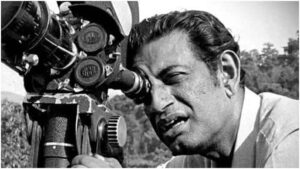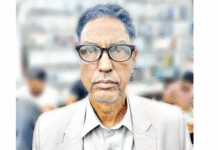Today we celebrate the birth centenary on arguably India’s best film maker ever, Satyajit Ray. For sheer art of film making or portraying film making or weaving a plot to create a realistic film no artist surpassed Satyajit Ray. He simply took the art of film making to a new dimension. With the simplicity of stream water he could convey his theme but still be poetic in sublime proportions. His creativity reached regions of divinity in the class of Rembrandt or Beethoven.Rarely could any director give so much life to a realistic movie. Ray displayed the mastery of a conductor of an orchestra when directing. His best works were like famous monuments sculpted with every member of the cast woven into a plot with mesmerising skill. Without virtually any element of melodrama or extensive dialogues, his movies could still be as buoyant as commercial films. Ray did not profess any ideology but in a most subtle or classical manner projected a moral or theme. In the Brechtian manner he made an audience think for him and be detached. No filmaker more illustratively touched upon the root cause of social upheaval of what characteristic shaped it. In his lifetime Prime Minister Nehru became a great fan of Satyajit Ray, and inspired him to make more films. In the moral sense no Indian director received as much recognition as Ray. He was simply an institution by himself. I can’t forget the appraisal even Communist revolutionaries had for Ray. His films were not social propaganda but the goal of takings social awareness to its highest volume. His synthesis of character into a story was so articulate and surgical that one saw no trace of dogma. Today with Hindutva Neo-fascism at an ascendancy as never before or the monopoly of corporate and globalization at a magnitude never transcended we all the more need a filmmaker like Satyajit Ray or films that adopt his forms.It is one of the most challenging tasks confronting progressive artists. Ray was never attached to any Communist group but still his films exposed the evils of the capitalist system or feudalism with even more effect than radical cultural artists. I see his role in film making similar or an equivalent to what Late poet Samar Sen was as a revolutionary intellect, through journal ‘frontier.’On the ground no filmmaker countered imperialist culture in such depth as Ray. I really wish Satyajit Ray had lived in the time of the Babri Masjid demolition, Godra riots or even Operation Greenhunt.He could well have compiled a classical movie based on these events .Ray was also a champion in harnessing the creative talents of an artist to the highest scale as well as scene dissection. The Hindi film industry badly misses a true equivalent of Satyajit Ray. I wish one day a film is made portraying the life of this icon.
Artistically Pather Panchali is his best film as well as Abu Sansar,Charulata ,Ghare Baire ,Nayak and Apparaito.
Pratidwandi and Ganashatru are two of his most progressive films politically.
Pratidwandi Movie (1972)without directly portraying Marxist or Naxalite ideology brilliantly does justice to the background of the Naxalite movement and it’s impact on transforming the lives of people. Taking film artistry to sublime proportions he portrays what wee the root causes of the uprising springing through the life experience of a youth. The ebb and flow in the life of Siddharha enacted by Dhritiam Chatterjee in an interview, in a coffee house when offered work as a Communist party cadre ,in a film hall where a mob explodes and when he notices a beautiful woman on the road is welded with a flashback giving the movie classical overtones. No film ever depicted the realism of the earlier 1970’s in West Bengal during naxalite uprising.I recommend anyone who whats an insight into the Naxalite film to see it.
Siddhartha (Dhritiman Chatterjee) is forced to discontinue his medical studies due to the unexpected death of his father. He has to now find a job instead. In one job interview, he is asked to name the most significant world event in the last ten years. His reply is ‘the plain human courage shown by the people of Vietnam’, instead of the expected: man landing on the moon. The interviewer asks if he is a communist. Needless to say, he does not get the job.
He reaches a coffee shop where he is offered work for the communist party. When he does not show any interest, the party leader tells him about an opening for a medical representative. To escape from the heat and have a snooze, he goes into a cinema. As a government propaganda newsreel is being shown before the feature, a bomb explodes in the cinema hall. In the stampede that follows, Siddartha breaks his watch. He goes to a watchmaker but he cannot afford the repairs.
Waiting to cross the road, he notices a beautiful woman. He drifts back to his days as a medical student in a flashback. The professor is explaining the anatomy of the female breast. Many flashbacks and dreams occur to Siddartha throughout the film. On his way to the hostel, he has an encounter with some hippies. Along with an ex-classmate, he goes out to see an uncensored Swedish film but, to their disappointment, the film turns out to be boring. In such constant wandering in Calcutta, disintegrating relationships with his sister and a Naxalite (militant communist) brother, his friendship with Keya is the only thing that keeps him sane.
Keya is a simple girl. Siddharta and Keya enjoy each other’s company but they cannot make any commitment to each other due to the circumstances. After yet another attempt at a job interview, Siddhartha leaves the big city to take a modest job as a salesman in a far off small town. He writes to Keya that he still cherishes their relationship. He also hears the call of a bird that he remembers from his childhood in his dreams but this time it is for real, and not in his mind. After completing the letter, he comes out to the balcony of his modest room. The bird calls again. He also hears the sombre chants of a funeral procession. As he turns to the camera, the picture is frozen.
The ending is reminiscent of the first scene which shows the death of Siddhartha’s father. However, the last scene is symbolic of the end of Siddhartha’s aspirations of finding a job in Calcutta.
In Ganashatru(1990) Ray has produced a masterpiece portraying the crusade of a young doctor against poisoned water caused by a temple which is the source of income for greedy politicians. It revolves around the machinations that breed tumours of injustice so inherent in a Hindu communal society and how it generates vengeance or revolt in people. I can’t think of a more relevant film today when we witness such a patronage of the Kumbh Mela or such glorification of temples by the saffron rulers.
Ashoke Gupta, played by Soumitra Chatterjee, an honest doctor, diagnoses the alarming spread of jaundice among his patients. To identify the cause, he analyses the water of a populated part of his town, Chandipur. According to the report, the holy water (charanamrita) of the Tripureshwar temple, a famous temple and tourist attraction of the town, is found to be contaminated due to damage to the underground piping system.
The temple was the source of income for all of the corrupt politicians. Among these politicians is Dr. Gupta’s younger brother, Nishith Gupta, portrayed by Dhritiman Chatterjee, who is also the chairman of the municipality. He and other beneficiaries of the temple decides to prevent the doctor from alerting the people.
As a responsible member of society, the doctor tries to broadcast the fact of contamination to the people, proposing temporary closure of the temple for water purification. However the Chairman is absolutely against this idea as it tampers with their profits. They are not ready to accept scientific evidence and instead says charanamrita can never be contaminated because it is holy.
He also tries to publish an essay in a local daily newspaper (Janabarta) on the topic. But the corrupt officials suppress his voice as the facts would inevitably decrease the temple’s income. The newspaper rejects his essay, fearing political pressure and public rage.
As the story progresses, Dr. Gupta even tries to convey his message in a public meeting. Unfortunately, it is infiltrated and messed up by his brother and his associates. The Chairman is able to manipulate the community against the doctor’s attempts to save it. He faces a widespread angry response and he goes from being a leader of society to an enemy of the people. Dr. Gupta loses his job in the local hospital and his daughter is terminated from her post of a teacher. The landlord asks them to move out.
However, at the end of the movie Dr. Gupta gets justice. The young educated population of the town sides with him while his son-in-law’s theatre troupe campaigns for him. The assistant editor of Janabarta quits his job to side with him and send his writing and interview to top newspapers in Kolkata.
The film ends in Gupta family deciding to stay in Chandipur, amidst a shout of “Long Live Dr. Ashok Gupta!” around him.
Pather Panchali(1955) is based on a novel written by Bibhutibhushan Bondopadhay. The story revolves around a boy called Apu and his elder sister Durga. The film narrates the tale of a poverty-stricken Bengali family. Ray was the equivalent of magician or wizard in projecting poverty in this film and revolving a set of characters. The permutations and combinations are simply a masterpiece with realism illustrated in subtle manner.
Pather Panchali is the first part of the Apu trilogy. The trilogy bestowed Ray with awards at Cannes, Venice and London.
In Nischindipur, rural Bengal, in the 1910s, Harihar Roy earns a meagre living as a pujari (priest), but dreams of a better career as a poet and playwright. His wife Sarbajaya takes care of their children, Durga and Apu, and Harihar’s elderly cousin, Indir Thakrun. Because of their limited resources, Sarbajaya resents having to share her home with the old Indir, who often steals food from their already bare kitchen. At times, Sarbajaya’s taunts become offensive, forcing Indir to take temporary refuge in the home of another relative. Durga is fond of Indir and often gives her fruit she has stolen from a wealthy neighbour’s orchard. One day, the neighbour’s wife accuses Durga of stealing a bead necklace (which Durga denies) and blames Sarbajaya for encouraging her tendency to steal.
As the elder sibling, Durga cares for Apu with motherly affection, but spares no opportunity to tease him. Together, they share the simple joys of life: sitting quietly under a tree, viewing pictures in a travelling vendor’s bioscope, running after the candy man who passes through the village, and watching a jatra (folk theatre) performed by a troupe of actors. Every evening they are delighted by the sound of a distant train’s whistle. One day, they run away from home to catch a glimpse of the train, only to discover Indir sitting dead on their return.
Unable to earn a good living in the village, Harihar travels to the city to seek a better job. He promises Sarbajaya that he will return with money to repair their dilapidated house. During his absence, the family sinks deeper into poverty. Sarbajaya grows increasingly lonely and bitter. One day during the monsoon season, Durga plays in the downpour for too long, catches a cold and develops a high fever. Adequate medical care being unavailable, the fever becomes worse, and on a night of incessant rain and gusty winds, she dies. Harihar returns home and starts to show Sarbajaya the merchandise he has brought from the city. Sarbajaya, who remains silent, breaks down at the feet of her husband, and Harihar cries out in grief as he discovers that he has lost his daughter. The family decide to leave their ancestral home. As they start packing, Apu finds the necklace that Durga had earlier denied stealing; he throws it into a pond. Apu and his parents leave the village on an ox-cart.
Ghare Baire (1985) is the portrayal of one of the best ever blending of contrasting characters, in period of Lord Curzon’s rule. Sensitivity and creativity taken to regions of the sublime .The true meaning of love revealed and what enables a human being to cultivate it. Touches revolutionary ideals or politics in a very subtle manner, in projecting nationalist movement. One of the best love trilogies ever in Indian films.
The story is set in 1907 on the estate of the rich Bengali noble Nikhilesh (Victor Banerjee). In the chaotic aftermath of Lord Curzon’s partition of Bengal into Muslim and Hindu states, the nationalist movement is trying to impose a boycott of foreign goods by claiming that imports are at the root of Indian poverty. He lives happily with his beautiful wife Bimala (Swatilekha Sengupta) until the appearance of his friend, a revolutionist, Sandip (Soumitra Chatterjee).
Sandip, a passionate and active man, is a contradiction to the peace-loving and somewhat passive Nikhilesh. He easily attracts the innocent and unsuspecting Bimala, creating a love triangle. Although Nikhilesh figures out what is happening, he is a mature person and grants Bimala the freedom to grow and choose what she wants in life, as their marriage was arranged when she was a girl. Bimala experiences the emotions of love for the first time in a manner that helps her understand that it is indeed her husband Nikhilesh who really loves her. Importantly, Nikhilesh tells Bimala that he would like her to have a life not only inside the home, but outside of it as well — a controversial stance in 1916 when the novel was written.
Aparajito (The Unvanquished) is the second film of the Apu trilogy and it is also based on Bibhutibhushan Bondopadhay’s novel. Unlike the first film, Ray did take some cinematic liberties with this one. It is said that he had no plans of making Aparajito, but after Pather Pachali’s international success, Ray apparently wanted to show the audience Apu’s life. The film is set in the city of Varanasi and depicts Apu’s college life.
Apur Sansar ((1959) is the last film of the Apu trilogy and it shows Apu’s childhood, adolescence and adulthood. In this film, Apu wins a scholarship to Calcutta. It also narrates the tale of his marriage and how he loses his mother and wife. The film features Ray’s favourites Soumitra Chatterjee and Sharmila Tagore.
Charulata (1964)is based on Rabindranath Tagore’s novel ‘Nastanirh’. The film narrates the tale of Charulata, who is married to a workaholic newspaper editor, Bhupati. The film is known for its timeless quality. It shows Charulata’s affection for Bhupati’s cousin, Amal in a very subtle manner. In fact, it is said that Charulata was Ray’s personal favourite.
There could not have been abetter projection of the Bengali Reconnaissance and its intervention with British rule.It bringst o the fore the chracter of an idealist like Bhupati,enacted by Sailen Mukherjee and the deep artistic fervour in Charulata enacted by Madhabi Mukherjee .Brilliant blending of a freedom fighter with an artist.
Charulata is based on a story by Rabindranath Tagore, Nastanirh (the Broken Nest) and set in Calcutta in the late nineteenth century. The Bengali Renaissance is at its peak and India is under British rule. The film revolves around Charulata (Charu) (Madhabi Mukherjee), the intelligent and beautiful wife of Bhupati (Sailen Mukherjee). He edits and publishes a political newspaper. Bhupati is an upper-class Bengali intellectual with a keen interest in politics and the freedom movement.
Charu is interested in the arts, literature and poetry. Though Bhupati loves his wife, he has no time for her. She has little to do in the house run by a fleet of servants. Sensing her boredom, Bhupati invites Charu’s elder brother Umapada and his wife Manda to live with them. Umapada helps in running the magazine and the printing press. Manda, with her silly and crude ways, is no company for the sensitive and intelligent Charulata.
Amal (Soumitra Chatterjee), Bhupati’s younger cousin, comes to visit. Bhupati asks him to encourage Charu’s cultural interests. Amal is young, handsome and in the same age group as Charu. He has literary ambitions and shares her interests in poetry. He provides her with much needed intellectual companionship and attention. An intimate and teasing friendship develops between Charulata and Amal. There is a hint of rivalry when she publishes a short story on her own without his knowledge, following his publishing of a poem that she had forbidden him from getting published. He realizes that Charulata is in love with him but is reluctant to reciprocate due to the guilt involved.
Meanwhile, Charu’s brother and sister-in-law swindle Bhupati of his money and run away. It destroys Bhupati’s newspaper and the press. The episode shatters Bhupati who admits his hurt to Amal. He tells Amal that now Amal is the only one he can trust.
Amal is overcome with the guilt of betraying his cousin. He is also uncomfortable with Charu’s higher intellect that he has helped nurture. He leaves unannounced to marry and go to England for higher studies. He leaves behind a letter to Charu.
Charu is heartbroken but hides her disappointment. Bhupati accidentally enters her room and finds her crying over Amal. Bhupati realizes Charu’s feelings for Amal. He is broken, shocked and bewildered by it.
Teen Kanya (1961) is inspired by an anthology penned by Rabindranath Tagore. The film originally contained three stories – ‘The Postmaster’, ‘Monihara’, and ‘Samapti’. However, it was later clubbed into two stories and released under the title ‘Two Daughters’, which didn’t include ‘Monihara’.
The Satyajit Ray directorial is inspired by Rabindranath Tagore’s short stories and is divided into three parts – ‘The Postmaster’, ‘Monihara’, and ‘Samapti’. Originally it had three separate stories; so the title is ‘Teen Kanya’. However, the subtitling wasn’t finished in time for a Tagore anniversary, so the second story ‘Monihara’ wasn’t included in the cassette, retitled ‘Two Daughters’. In the two stories, we see the lives of two girls bound to a world, not of their making, so they face their fate with very limited options. ‘Monihara’ sees a school teacher telling the story of a zamindar’s wife Manimalika, who was a jewelry-crazy lady. When her husband faces financial problems, Manimalika gives all her jewelry and then disappears. The zamindar then in a deserted house opens the new box full of jewels that were meant for his wife, suddenly there is maniac laughter all around and Manimalika’s spirit comes to snatch all the jewels.
Nayak (1974) is film starring Uttam Kumar, Nayak revolves around the life of a lonely man who shares his deepest secrets with the viewers during a 24-hour train journey.
Sonar Kella.This film is based on Satyajit Ray’s most loved and popular mystery novel of the same name. Starring Soumitra Chatterjee as Feluda, it narrates the tale of a detective. One of the most artistic portrayals ever of the travels in a train involving an actor travelleling to receive an award at a function. Character acting of classical stature. The story revolves around a film star on a 24-hour train journey from Kokata to Delhi to receive a national award. However, he ends up revealing his mistakes, insecurities and regrets to a young journalist, who realises that behind all his arrogant facade lies a deeply troubled man as his life’s story is gradually revealed through seven flashbacks and two dreams. One of the finest depictions of essence of inner character and what shapes a man’s arrogance.
Greatly indebted to Wikipedia and Outlook India for reference information.
Harsh Thakor is a freelance journalist. Toured India, particularly Punjab .Written on Mass movements ,,Massline,Maoism on blogs like Democracy and Class Struggle and frontierweekly .An avid cricket lover too who has posted writings on blogs like Pakpassion Indian Cricket Fans and Sulekha.com.
Email- thakor.harsh5@gmail.com










